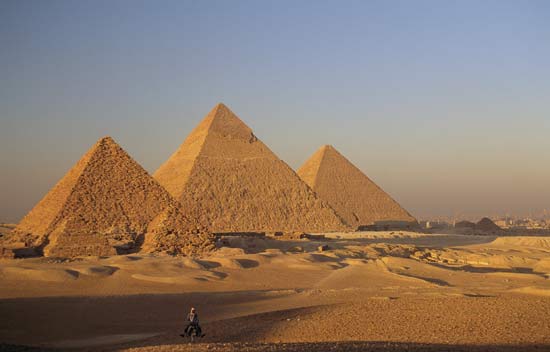The seven wonders of the world, which is generally called the Seven Wonders and the seven wonders of the ancient world, are a set of architectural works that the Greeks, especially the Hellenistic period, considered worthy of being visited, being for them famous monuments of creation and human ingenuity. Following are the seven wonders of the ancient world:
1. Great Pyramid of Giza: The Great Pyramid of Giza is the oldest of the Seven Wonders of the World and the only one still exists, besides being the largest of the pyramids of Egypt. It was ordered built by the pharaoh of the Fourth Dynasty of Ancient Egypt Khufu. The architect of this work was Hemiunu. The estimated completion of construction of the Great Pyramid is dated around 2570. C., and being the first major of the three great pyramids of Giza Necropolis, located on the outskirts of Cairo, Egypt. It was the tallest building until the fourteenth century and the building highest stone of the world until the nineteenth century, being then superseded by the church steeple St. Nikolai, Hamburg.
2. Hanging Gardens of Babylon: Starting from a love story, the Hanging Gardens of Babylon have been immortalized in time and are part of one of the Seven Wonders of the Ancient World. The story goes that around 600 a. C. Nebuchadnezzar II, king of Shinar, wanted to give his wife, Amytis, present to show his love towards her. That’s how this beautiful project designed by architects of Babylon was born. The gardens is spread over an area of 19,600 square meters that had a series of terraces of vaulted stone supported on pillars where they could plant large trees. Moreover, these terraces were fed by several streams that obtained water from a reservoir at the highest terrace. According to the stories, looking at the work from below the terraces seemed suspended in time.
3. Statue of Zeus at Olympia: The Statue of Zeus at Olympia was made by famed classical sculptor Phidias about 436. C., which is now known as Olympia, Greece, and part of the Seven Wonders of the Ancient World. The statue occupied the whole width of the aisle of the temple built to house it. According to a contemporary source was approximately forty feet high. Zeus was carved in ivory (or modeling, as in carrying ivory was soaked in a liquid that made it more malleable) and gold accents were solid gold.
4. Temple of Artemis at Ephesus: The Temple of Artemis was a temple complex located in the city of Ephesus, Turkey, dedicated to the goddess Artemis, called Diana by the Romans. Its construction was started by King Croesus of Lydia and lasted about 120 years. Large and beautiful architecture, is considered one of the Seven Wonders of the Ancient World, as described by Antipater of Sidon, who developed the famous list. The temple was composed of numerous buildings, archaeologists called with successive letters. The Temple of Artemis was destroyed by fire in the year 356. C.
style=”display:inline-block;width:600px;height:200px”
data-ad-client=”ca-pub-7770941721586396″
data-ad-slot=”2763174660″>
5. Mausoleum at Halicarnassus: The Mausoleum at Halicarnassus or Tomb of Mausoleion was a tomb built between 353 and 350 BC. C.1 at Halicarnassus for Mausolus, a satrap in the Persian Empire. The structure was commissioned by his wife and sister Artemisia II of Caria, the Greek architect of Paros and Satyr Piteo.2 3. The mausoleum was approximately 45 meters high, and each of the four plants was adorned with sculptural reliefs created by each one of the Greek sculptors – Leochares, Briaxis, Scopas of Paros and Timoteo. The structure of the mausoleum was considered a great triumph aesthetic, while Antipater of Sidon regarded him as one of the Seven Wonders of the World. This building also indicates a new trend in the monumental art of post-classical or Hellenistic period.
6. Colossus of Rhodes: The Colossus of Rhodes was a statue of the Greek god Helios, created by sculptor Cares of Lindos on the island of Rhodes (Greece) in 292. C. and destroyed by an earthquake in 226. C. It is considered as one of the Seven Wonders of the World. All that is known about this statue is due to the news that left ancient writers Pliny the Elder, and Strabo Polibio, and the Byzantine chronicles of Constantine VII Porphyrogenitus, Michael the Syrian and Philo. The statue (made with bronze plates over an iron frame) represented the Greek sun god, Helios.
7. Lighthouse of Alexandria: The Lighthouse of Alexandria was a tower built in the third century. C. (between 285 and 247 a.) On the island of Faro in Alexandria, Egypt to serve as a reference point as port and lighthouse. With a population estimated between 115 and 150 meters (383-450 feet) height was one of the structures by the highest man made for many centuries, and was identified as one of the Seven Wonders of the World by Antipater of Sidon. It would be shot down by the effects of an earthquake in the early fourteenth century. Construction of the lighthouse consisted of a large square base and an octagonal tower 100 feet high. On top of burning wood and resin, that served light and warning signal to mariners.
